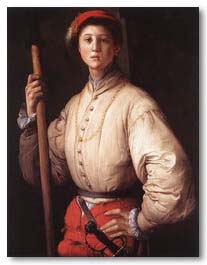Chauncey Devereux Stillman
- REV. GEORGE RUTLER
Of wealth and war, Chauncey Devereux Stillman (1907-1989) knew much and said little.
 |
The
Halberdier
Jacopo Pontormo 1530s |
He did write a life of his great-grandfather Charles who left colonial roots in Connecticut to establish a fortune in Mexican cotton, real estate, and silver mines. Moving north to Texas, he helped bankroll an attempted invasion of Mexico by Carbajal and founded Brownsville, much of which he bequeathed to his son James who became president of what is now the Citigroup bank. By the end of the Civil War, Charles Stillman was one of the richest men in America. John D. Rockefeller's brother William had two daughters who married two of James's sons. One of the couples bore a son named for Chauncey Depew, head of the New York Central Railroad.
In his country home in Dutchess County, now a museum he endowed, is a youthful portrait that makes it easy to imagine Chauncey in Paris in the Roaring Twenties. In 1942, the future commodore of the New York Yacht Club donated his gorgeous flagship Westerly as a patrol boat on the lookout for German submarines. As squadron air combat intelligence officer on the USS Enterprise, he fought in the Battle of Leyte Gulf in October of 1944 and wrote the history of his Air Group 20, which in three months sank 33 ships and destroyed 345 enemy airplanes. Later he served as a staff officer with the National Security Council.
Schools and charities flourished by his philanthropy, especially after his embrace of Catholicism. The Gentleman of His Holiness was an efficient cause of many of the Church's most vigorous new academic and cultural institutions. One regret Chauncey vouchsafed to me in this regard was the abuse of the chair of Roman Catholic Studies that he had endowed at the Harvard Divinity School. Christopher Dawson was its first holder until 1962, and Stillman thereby was the chief publicist of that formerly neglected genius, but since then the professorship has gone the unhappy way of the school itself. The university ignored Chauncey as curtly as it had eagerly accepted his largesse. The day after our discussion, the incumbent professor unexpectedly died.
| The last Mass he heard was in his Madison Avenue apartment, and his whispered request of me was that the sign of peace be omitted "because the butler finds it awkward." |
His 1,200-acre Wethersfield estate declared a lifelong enthusiasm for nature and wildlife preservation. Ten acres of formal Italian gardens were designed by Evelyn Poehler, whose husband Fred was one of the last great beaux arts architects. Chauncey promoted the current revival of classical design and, with his own degree in architecture from Columbia University, built his Georgian house with its collection of Toulouse-Lautrec, Sargent, Degas, and numerous Cassatts (Mary's family had the Pennsylvania Railroad and were old friends of the Stillmans). A Murillo hung in his chapel. Pietro Annigoni spent a year painting frescoes in the Gloriette, a ballroom that was a frisky variant of the Sistine Chapel. He would surrender his own bedroom so that I could wake up facing Gilbert Stuart's Washington. The prize of all was The Halberdier by Pontormo. Had Stillman not decided at the last minute to risk flying it over from Italy for an early exhibition, it would have gone down with the Andrea Doria. Sale of it in 1989 for $34 million, then the highest price ever paid for an old master, helped to fund a foundation for Catholic culture.
Aesthetics did not throttle ascetics, and when he was dying of lung cancer I occasionally met him praying the rosary in a hideously modern Manhattan basement chapel. The last Mass he heard was in his Madison Avenue apartment, and his whispered request of me was that the sign of peace be omitted "because the butler finds it awkward." I obliged the Gentleman of His Holiness and the gentleman's gentleman, and I perpetuate that final wish as often as I can.
 This is Meaghen Gonzalez, Editor of CERC. I hope you appreciated this piece. We curate these articles especially for believers like you.
This is Meaghen Gonzalez, Editor of CERC. I hope you appreciated this piece. We curate these articles especially for believers like you.
Please show your appreciation by making a $3 donation. CERC is entirely reader supported.

Acknowledgement
Rev. George W. Rutler. "Chauncey Devereux Stillman." Crisis (September 2005).
This article is reprinted with permission from the Morley Institute a non-profit education organization.
This article appeared first as one of the "Cloud of Witnesses" columns Father Rutler wrote for Crisis. It is included in his book, Cloud of Witnesses - Dead People I Knew When They Were Alive.
The Author
 Father George W. Rutler is the pastor of St. Michael's church in New York City. He has written many books, including: The Wit and Wisdom of Father George Rutler, The Stories of Hymns, Hints of Heaven: The Parables of Christ and What They Mean for You, Principalities and Powers: Spiritual Combat 1942-1943, Cloud of Witnesses — Dead People I Knew When They Were Alive, Coincidentally: Unserious Reflections on Trivial Connections, A Crisis of Saints: Essays on People and Principles, Brightest and Best, and Adam Danced: The Cross and the Seven Deadly Sins.
Father George W. Rutler is the pastor of St. Michael's church in New York City. He has written many books, including: The Wit and Wisdom of Father George Rutler, The Stories of Hymns, Hints of Heaven: The Parables of Christ and What They Mean for You, Principalities and Powers: Spiritual Combat 1942-1943, Cloud of Witnesses — Dead People I Knew When They Were Alive, Coincidentally: Unserious Reflections on Trivial Connections, A Crisis of Saints: Essays on People and Principles, Brightest and Best, and Adam Danced: The Cross and the Seven Deadly Sins.




